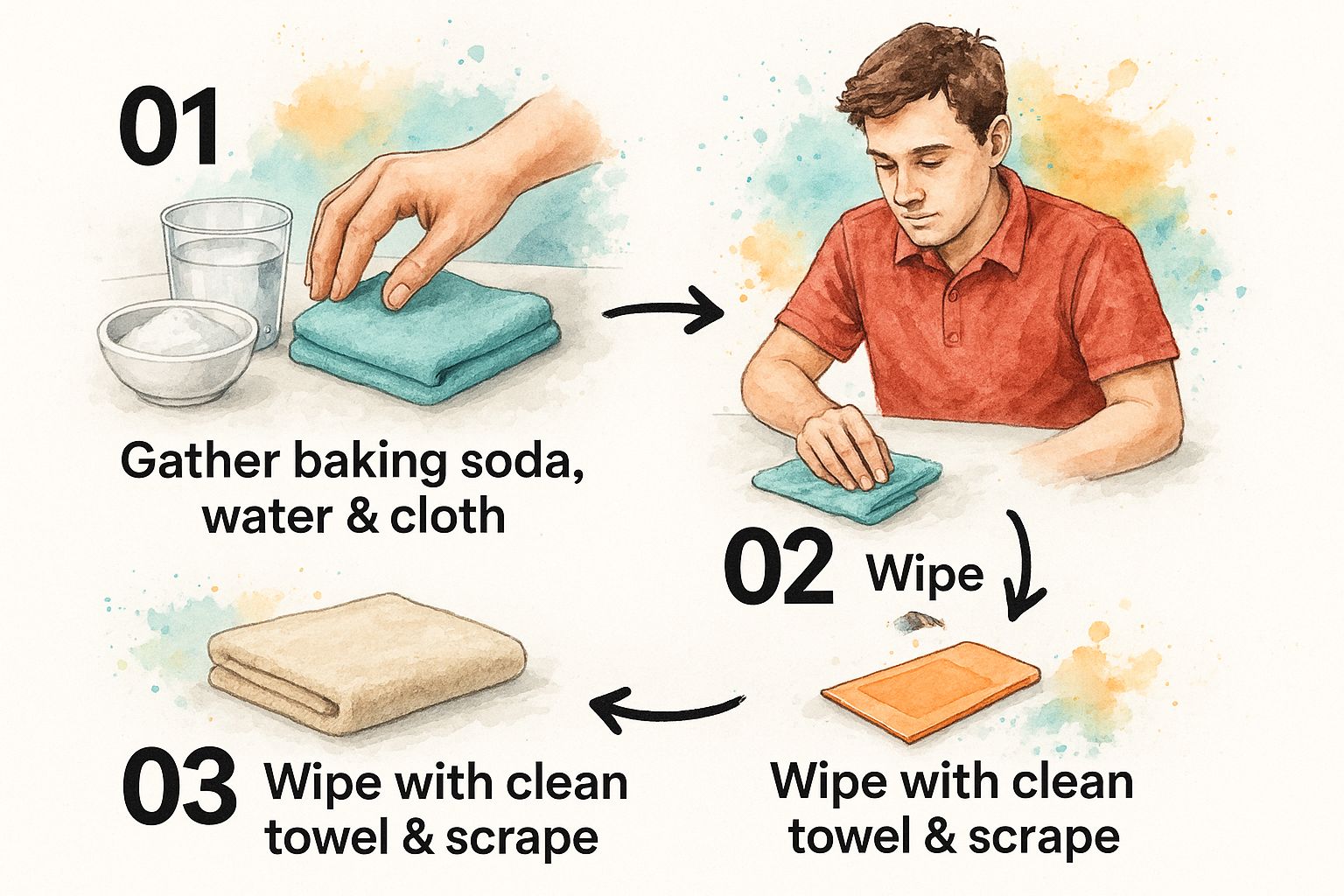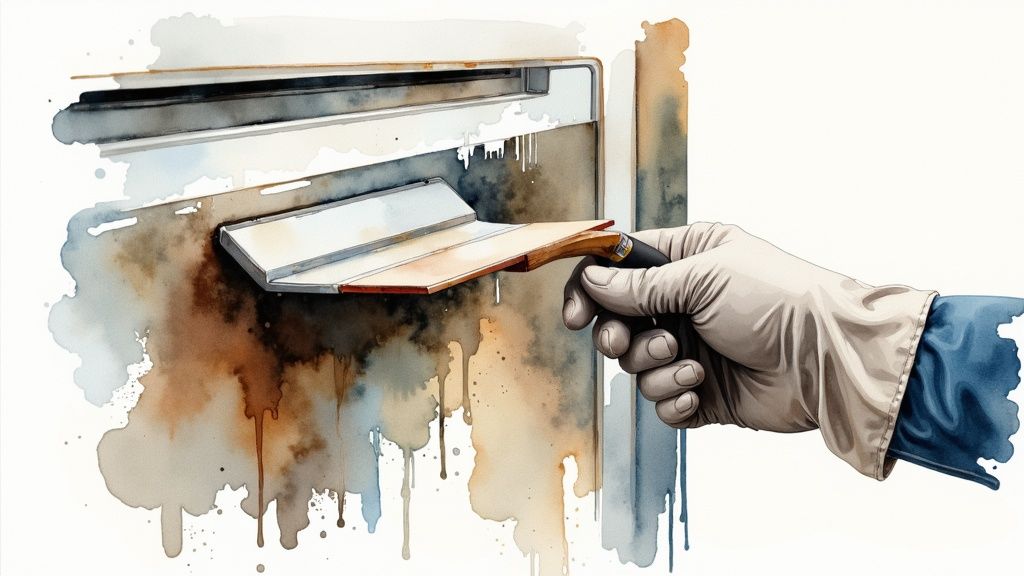You can get the glass on your oven door sparkling again using nothing more than bicarb soda and water. Yep, that's it. It's a fume-free method that genuinely cuts through grease without needing harsh chemicals. Most of the time, all it takes is a simple paste, a bit of patience… and a final wipe-down.
Why Is Cleaning Oven Glass So Hard?
That hazy, brown film clouding up your oven door isn’t just an eyesore. It’s a stubborn combination of grease splatters, burnt sugar, and forgotten spills that have been baked on over and over again. It’s almost like a ceramic glaze.
It’s one of those jobs that can make the whole kitchen feel a bit grubby, no matter how much you wipe down the benchtops. If you've been putting it off, you’re definitely not alone. So many people assume you need aggressive chemicals and a whole afternoon set aside to even make a dent in it. The build-up can get so tough that plenty of people just give up and call in the professionals.
The Cost of a Professional Clean
Calling in the pros is always an option, but it certainly comes at a price. In Sydney, for instance, the average cost for a professional oven clean is around $225. In Melbourne, it's about $207. These services get the job done, no doubt, but what if you could achieve the same sparkle with a few things you already have in the cupboard?
We're going to walk through some surprisingly simple methods that dissolve the grime without the fumes or the fuss. It's a much gentler approach than the heavy-duty methods often required when cleaning commercial kitchens.
This isn’t about scrubbing for hours. Not at all. It’s about letting a simple, gentle solution do the hard work for you. The real secret is patience, not power.
This is your first step to seeing that beautiful roast clearly again.
Gathering Your Simple Cleaning Tools
Before you even think about scrubbing, let’s get everything you need in one place. Prepping your tools beforehand is a bit like gathering ingredients before you start cooking. It just makes the whole process flow so much better.
And the best part? You almost certainly won't need a special trip to the shops for expensive, specialised products. You’ve likely got all this stuff already.
We’re going to focus on two proven approaches. The first is a gentle, natural paste that works wonders on most everyday grime. The second is for those really stubborn, baked-on spots that refuse to budge.
Your Go-To Cleaning Kit
For the natural method, you just need bicarb soda and a little bit of water. Seriously, that’s it. For tougher jobs, we might look at a dedicated store-bought oven cleaner or a simple plastic scraper.
You'll also want to grab:
- Two microfibre cloths. They're brilliant for getting a streak-free finish. One for cleaning, one for buffing.
- A small bowl for mixing your bicarb soda paste.
- Some old towels or newspaper to lay on the floor below the oven door. Trust me, this simple step will save you from cleaning up a messy, pasty puddle later.
This quick infographic shows the simple setup you'll need.

Having these few simple items ready before you begin turns what feels like a chore into a smooth, straightforward process. A little bit of preparation now saves a whole lot of hassle later on.
The Natural Paste for Everyday Grime

For that hazy, everyday build-up, this is the method I turn to most often. It’s gentle. It's completely fume-free. And it works wonders without needing harsh chemicals where you cook your food. Honestly, it just feels a lot better.
All you need is a simple paste made from bicarb soda and a bit of water. In a small bowl, mix about half a cup of bicarb soda with just enough water to get a thick, spreadable consistency.
You're aiming for something like toothpaste. If it’s too runny, it’ll just slide down the glass. Too thick, and it becomes a real pain to spread evenly.
Applying and Waiting
Once your paste is ready, it’s time to get it on the glass. Lay some old towels on the floor beneath the oven door, then use your fingers or a soft cloth to spread the paste all over the inside of the glass.
Don’t be shy with it. Pay extra attention to the corners where grease loves to hide and dab a little extra onto any stubborn, visible stains. The whole surface should be covered in a nice, even layer.
Now comes the most important part… patience.
You need to let that paste sit and do its thing for at least 20-30 minutes. This is where the magic happens. The alkaline nature of the bicarb soda gets to work breaking down all that acidic, baked-on grease, lifting it right off the glass for you.
The real secret here isn’t about how hard you scrub; it’s about giving the bicarb soda enough time to work. If you rush this step, you’ll be doing all the hard work instead of letting the paste do it for you.
After the time is up, grab a damp microfibre cloth and start wiping the paste away using gentle, circular motions. You’ll be amazed at how easily the grime lifts off, revealing a much cleaner surface without any of that endless, frustrating scrubbing.
Keep wiping until all the residue is gone, then grab your second, dry microfibre cloth and buff the glass to a sparkling, streak-free shine.
How to Tackle Stubborn Baked-On Stains

Sometimes, the gentle bicarb paste just doesn’t cut it. We’ve all been there. Staring at those dark, almost black spots that seem permanently fused to the glass, laughing at our best cleaning efforts.
When you’re up against that level of baked-on grime, it’s time to bring in a slightly stronger approach. Don’t worry, we’re still going to do this safely without damaging your oven.
For those really tough, carbonised marks, a flat-edged plastic scraper can work wonders. If you don’t have one handy, a new, clean razor blade held carefully will also do the trick. The key is to hold it at a very low, flat angle against the glass, almost parallel to the surface. Think about how you’d scrape a sticker off a window.
The most important thing here is to never use the corner of the blade. Always use the flat edge to gently lift the baked-on grime. This isn't about brute force. It’s about carefully getting underneath the stain without scratching the glass.
When to Consider a Commercial Cleaner
If scraping still isn’t shifting the worst of it, it might be time for a store-bought commercial oven cleaner. These products are specifically designed to dissolve what a natural cleaner couldn't handle, but choosing the right one is crucial.
Look for a product that clearly states it’s safe for glass surfaces. It’s also worth remembering that many appliances and cleaning products in Australia are imported. Australia's reliance on imports, particularly from China, can influence the types of cleaning solutions available. You can discover more insights about the Australian domestic appliance market on indexbox.io.
When you reach for a commercial cleaner, follow these simple but vital steps:
- Ventilate the area. Open up windows and doors before you even think about spraying. The fumes can be pretty potent.
- Protect your surroundings. Lay down plenty of newspaper or old towels on the floor to protect it and your surrounding cabinetry from any drips.
- Follow the directions. Always read the instructions on the bottle. Some cleaners work best on a slightly warm oven, while others are strictly for cold surfaces only. Get this wrong, and you could end up with a bigger mess.
A Deeper Clean Between the Glass Panels
Ever finished cleaning your oven door, stood back to admire your work… only to spot a hazy streak you just can't wipe away? It’s incredibly frustrating. The problem isn’t your cleaning technique. The mess is probably on the inside.
Many modern ovens have doors with two panes of glass. Over time, dust, greasy steam, and condensation can sneak in between them, creating a stubborn film that no amount of scrubbing on the outside will ever touch.
Taking the oven door apart sounds like a huge, complicated job, but for most models, it's simpler than you might think. It's the secret step to getting that truly flawless, showroom-clean look.
Safely Separating the Glass Panels
First things first, find your oven's manual. If you can’t put your hands on the paper copy, a quick Google search for your oven's make and model number will usually bring up a PDF version you can download.
The manual is your best friend for this task. It will have the specific instructions you need to safely remove the door and, most importantly, how to separate the glass panels without cracking or chipping anything. Oven doors can be surprisingly heavy and awkward, so it’s not a bad idea to ask someone for a helping hand.
Once the panels are apart, you won't need any hardcore chemicals. The grime inside isn't baked on like the stuff inside the oven. A standard glass cleaner or even a simple solution of vinegar and water will work perfectly. Just give it a spray and wipe it down with a clean microfibre cloth.
The most important part of this whole process is putting it all back together correctly. Take a photo before you start unscrewing things, keep all the screws in a little bowl so none go missing, and follow the manual's instructions in reverse. This makes sure everything is secure and aligned properly.
For tricky cleaning jobs like this one, or for other specialised tasks around the home, it can be helpful to see how the pros do it. Looking into professional specialty cleaning services can give you some great insights and techniques for tackling those tough spots.
Keeping Your Oven Glass Clean for Good
Now that your glass is sparkling, let’s talk about how to keep it that way. You really don’t have to do a deep, intensive clean every single week to maintain that shine. It’s all about building small, consistent habits that stop the mess before it starts.
The single most powerful trick? A quick wipe-down with a damp microfibre cloth after a particularly messy cook. Just wait until the oven has cooled down completely, then give the glass a once-over. This simple action stops grease splatters from baking on in the first place, which is half the battle won.
A Simple Maintenance Routine
For ongoing maintenance, a quick bicarb paste treatment every month or so is all you need. It’s not a big production. A few minutes is all it takes to prevent you from ever having to face a major, back-breaking scrubbing session again.
Think of it as five minutes of prevention that saves you a solid hour of hard work down the track.
This focus on appliance care is becoming more common. In fact, the Australian household appliances market was valued at USD 7.49 billion in 2024 and is set to grow. With a big emphasis on home cleanliness, keeping appliances in top shape is a priority for many households. You can explore more about these trends in the appliance market on grandviewresearch.com.
It's a bit like wiping down your benchtops after cooking. You wouldn’t let food sit there for weeks, and the same thinking applies to your oven glass. A little effort now saves a huge job later.
This approach not only keeps your oven looking great but also simplifies bigger cleaning tasks, like when you’re preparing for an inspection. If you want to get ahead, having a solid plan helps, and our end-of-lease cleaning checklist offers some great tips for tackling the whole house.
When your cleaning tasks feel too big to handle alone, the team at That Cleaning Crew is here to help. Get a free on-site quote and let our professionals restore the sparkle to your space. Visit us at https://www.thatcleaningcrew.com.au.

